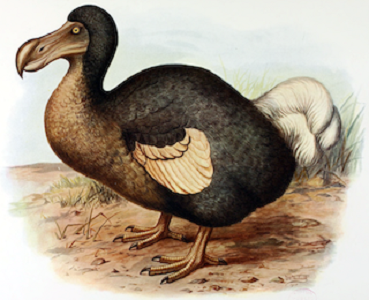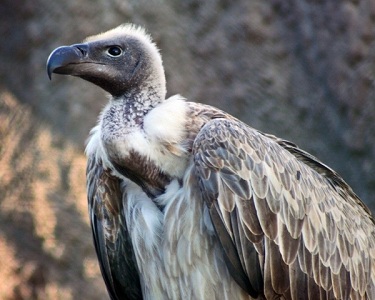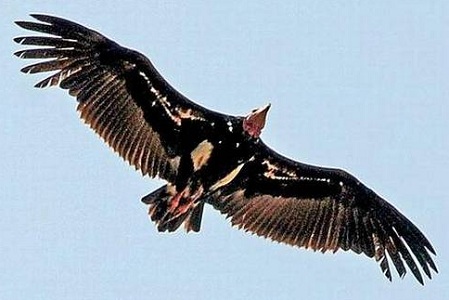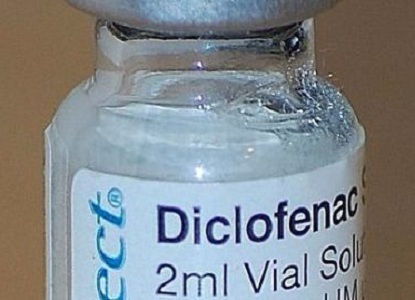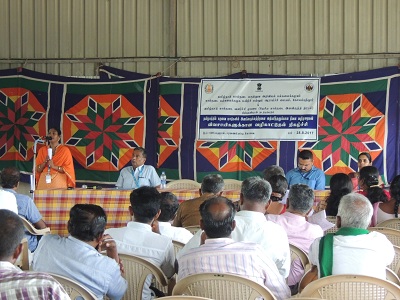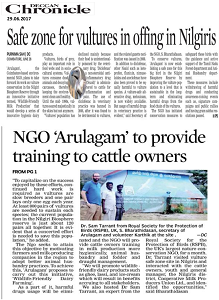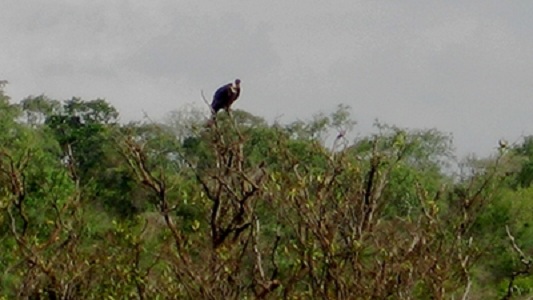கொரோனா நோய்த் தொற்றியும் பாறு கழுகுகளும்
கேட்டவுடனே அச்சத்தைத் தரும் ஒரு சொல்லாக 'கொரோனா' என்ற சொல் நம் செவிப்பறையில் மோதுகிறது . 'கொரோனா' போன்ற நுண்மிகளை (virus) மனிதகுலம் காலங்காலமாகச் சந்தித்து அதிலிருந்து மீண்டு வந்து கொண்டு தான் இருக்கிறது. இதிலிருந்தும் மீண்டுவிடுவோம். அதற்கு மருத்துவம் துணை நிற்கும். ஐயம் தேவையில்லை. அதே வேளையில், இதற்கு இயற்கையும் அதன் அங்கமான பல்லுயிர்களும் மறைமுகமாகத் துணைபுரிந்து இப் பூமிப் பந்திலுள்ள உயிரினங்களை முற்றிலும் அழிய விடாமல் காக்க முயலும் என்பதை நம்புவோம்.
வளர்ந்த நாடுகளுக்கு இணையான சுகாதாரக் கட்டமைப்பு வசதிகளோ தன் சுத்தம் பேணும் மக்களோ இந்தியாவில் இல்லை என்ற குறை சுட்டிக் காட்டப்படுவதை நாம் அடிக்கடி கேட்டிருப்போம். ஆனால் இவ்வளவு மக்கள் தொகையும் எப்படித் தொற்று நோய்க் கிருமிகளிலிருந்து தப்பிக்கின்றனர்?. அதிலும் உடல்நலம், சுற்றுப்புறத் தூய்மை என்பன பற்றிப் பெரிதாக அலட்டிக்கொள்ளாத நம் மக்களை எது பாதுகாக்கின்றது? நம்மிடம் உள்ள நோய் எதிர்ப்பாற்றல் இதற்கு உதவியிருக்கக்கூடும் என்பது ஒருபக்கம் உண்மை. இதற்கு மறைமுகமான மறுபக்கம் ஒன்றும் உண்டு.
கொடிய தொற்று நோய்க் கிருமிகளைக் கட்டுக்குள் வைத்ததில் இந்தியாவிலுள்ள பல்லுயிர்களுக்கும் பெரும் பங்கு உண்டு. அதிலும் இறந்தவற்றை உண்டு வாழும் பாறு கழுகு போன்ற உயிரினங்களுக்கும் சிறப்பான பங்கு உண்டு. காட்டில் விலங்குகள் நீர்நிலைகளுக் கருகில் இறக்க நேர்ந்தால் அதிலிருந்து நோய் பரப்பும் நுண்ணுயிரிகள் தண்ணீரில் கலந்து அங்கு தாகம் தணிக்க வரும் மான்களுக்கோ யானைகளுக்கோ இதர விலங்குகளுக்கோ பாதிப்பு ஏற்படுத்தும் ஆபத்து உண்டு. அப்படிப்பட்ட சூழலில் பாறு கழுகு கூட்டம் வந்து இறங்கினால் இறந்த விலங்கின் உடல் இருந்த அடையாளமே தெரியாமல் தின்று தூய்மைப்படுத்தி விடும். இதனால் நீர்மூலம் பரவும் நோய்களும் இயற்கையாகவே கட்டுப்படுத்தப்பட்டன.
தவிர, விலங்குகளுக்கு ஏற்படும் கொடிய நோய்க் கூறுகளான அடைப்பான் (Anthrax), கழிச்சல் (Cholera), கோமாரி நோய் (அ) காணை நோய் (Foot and Mouth Disease), வெறிநோய் (Rabies), நச்சுயிரித் தொற்று(Distemper) உள்ளிட்ட தொற்று நோய்களால் மடிந்த விலங்குகளை உண்டாலும் பாறு கழுகுகளுக்கு ஏதும் ஆவதில்லை என்பது நமக்கு வியப்பைத் தரக்கூடும். அந்த நச்சு நுண்ணுயிரிகளை இதன் வயிற்றில் சுரக்கும் வீரியமான அமிலம் செயலிழக்கச் செய்து விடுகிறது என்கிறார்கள் அறிவியலாளர்கள். இதனால் பாறு கழுகுகளுக்கும் எந்த பாதிப்பும் ஏற்படுவதில்லை. இறந்த விலங்கிடமிருந்து தொற்று நோயும் பரவுவதில்லை. அதேபோல, இவற்றிடமிருந்தும் எந்த நோயும் பிற உயிரினங்களுக்குத் தொற்றுவதில்லை. இவ்வாறு அவை காட்டின் தூய்மைப் பணியாளராய் இருந்து எண்ணரும் உயிரினங்களைக் காக்கின்றன.
ஆனாலும் நாம் பாறு வகைப் பறவைகளால் என்ன பயன்? என்ற கேள்வியை அடிக்கடி கேட்கிறோம். நாம் எதையெடுத்தாலும் வட்டிக் கணக்கு போட்டும், பொருளாதாரக் கண்ணோட்டத்திலும், ஜிடிபி (Gross Domestic Product) அடிப்படையிலும் பங்குச் சந்தை குறியீட்டு எண் அடிப்படையிலும் ஒருநாட்டைப் பார்ப்பதால் பிற உயிரினங்களின் அருமை தெரிவதில்லை. இவை ஆற்றும் சேவையை இயந்திரத்தைக் கொண்டு செய்தால் எவ்வளவு செலவாகும் என்று பொருளாதாரக் கணக்குப்போட்டு பார்த்தால் அது அரசின் ஆண்டு நிதிநிலை அறிக்கையையும் ஏன் ஐந்தாண்டுத் திட்டத்தின் பயனையும் மிஞ்சும் படியாக இருக்கும் என்பதை மறுக்க முடியாது.
மேலும் இது போன்ற உயிரினங்கள் இல்லாது போனால் அது உணவுச் சங்கிலியில் மிகப்பெரும் அதிர்வலைகளை ஏற்படுத்தும் என்பது திண்ணம். அது உடனடியாக எதிரொலிக்காது. பாறு கழுகுகள் இல்லாத வெற்றிடத்தை நாய்களும் எலிகளும் எடுத்துக்கொள்ளும். நாய்களின் எண்ணிக்கை அதிகமானால் வெறிநோயின் (ரேபிஸ்) தாக்கமும் கூடுதலாகவும் வாய்ப்புண்டு. தென்னை மரத்தில் தேள் கொட்டினால் பனை மரத்தில் நெறிக்கட்டும் என்பதற்கேற்ப இப்படி ஒன்றுக்கொன்று தொடர்புண்டு. இவை எல்லாம் நேரா வண்ணம் இயற்கையாகவே ஒரு ஒழுங்கு கடைபிடிக்கப்பட்டு வந்தது. ஆனால் அதில் மனிதர்களின் தலையீடு கூடுதலாகக் கூடுதலாக அந்த ஒழுங்கு சீர்குலையத் தொடங்கியது. இதனால் பாதிக்கப்பட்ட உயிரினங்கள் ஏராளம்.
அப்படி ஒரு பேரழிவைத்தான் பாறு கழுகுகளும் சந்தித்தன. அவை பெருமளவு மடிந்ததற்கு, மாடுகளுக்குத் தரப்படும் வலி போக்கி மருந்தான டைக்குளோபினாக் மருந்து பெரும் பங்கு வகித்தது என்ற செய்தியைச் சொன்னபோது உலகம் நம்ப மறுத்தது. ஆனால் அசைக்க முடியாத ஆய்வுகளால் பின்னர் அதை ஏற்றது. இதை அறிந்து இந்தியா உள்ளிட்ட பல்வேறு வளர்ந்து வரும் நாடுகளும் அம் மருந்துக்குத் தடை விதித்தன. சுகாதாரத்தில் முன்னிலை வகிக்கும் வளர்ந்த நாடான இத்தாலியும் தடை விதித்தது. ஆனால் அந்தத் தடையை ஓரிரு ஆண்டுகளில் அந்நாடு விலக்கிக் கொண்டது. அதனைத் தொடர்ந்து ஸ்பெயினும் விலக்கிக் கொண்டது. பறவையாளர்கள் முறையிட்டும் அந் நாடுகள் கடைசி வரை செவி சாய்க்கவில்லை. எங்கள் நாட்டில் சுகாதாரச் சீர்கேடு இல்லை. வளர்ந்து வரும் நாடுகளைப் போல நாங்கள் இறந்த விலங்குகளை வெளியில் வீசுவதில்லை என்று மறுதலித்தது. ஆனால் அப்படி உயர்ந்த சுகாதாரம் பேணப்படும் நாட்டில் தான் 'கோரோனா' தன் கைவரிசையைக் காட்டியுள்ளது என்பதைச் சுட்டிக் காட்டக் கடமைப் பட்டுள்ளோம்.
பாறு கழுகுகளுக்கும் கொரோனோவிற்கும் நேரடியாகத் தொடர்பில்லை ஆயினும் கொரோனா போன்ற நச்சுயிரிகளின் ஆபத்தில் மனிதகுலம் சிக்கியுள்ள இவ்வேளையில் இதுபோன்ற தீநுண்மிகளை இயற்கையாக கட்டுக்குள் வைக்கும் பாறு கழுகு போன்ற உயிரினத்தைப் பற்றியும் தெரிந்து அதைப் பாதுகாக்க முன்வர வேண்டும் . பாறு செழிக்கட்டும்.
குயிலின் கூவலும் ஊரடங்கலும்
பறவைகளின் ஆரவாரமிக்கக் அகவல் என் மனதிற்கு எப்போதுமே குதூகலத்தைக் கொடுக்கும். வேலை நிமித்தமாக, என் பெற்றோர்கள் அதிகாலையிலேயே எழும் பழக்கம் உடையவர்கள் ஆதலால் ‘கோழி கூப்ட’ எழும் பழக்கம் எனக்கும் சிறுவயதிலிருந்தே பழக்கமாகி விட்டது.
கிராமங்களில் கோழிக்கும் சேவலுக்கும் பஞ்சமே இருக்காது. அதிகாலையில் ஒரு சேவல் கூவ ஆரம்பித்தவுடன் அடுத்த அடுத்த இடங்களில் வசிக்கும் சேவல்களும் எசப்பாட்டுப் பாட ஆரம்பித்து விடும். எங்கள் அண்டை வீட்டில் வயதான பாட்டி ஒருவர் வசித்து வந்தார். அவரது வீட்டில் எப்போதுமே கோழியும் சேவலும் இருக்கும். சிறுவயதில் நான் கண்விழித்தது அதன் கூப்பாட்டைக் கேட்டுத்தான். இந்த இடத்தில் அந்தப் பாட்டியைப் பற்றிய சிறு குறிப்பு. அவருக்கு இரு மகன்கள் உண்டு ஆனால் அவர்களிடம் அண்டிப் பிழைக்காமல் கோழி வளர்த்தே தனது பொருளாதாரத் தேவையை அவர் ஈடு செய்து கொண்டார். அவருக்கு, நல்ல சம்பாத்தியத்தில் நகர்ப்புறத்தில் வசிக்கும் தன் மூத்த மகன் மீது கூடுதல் பாசம் உண்டு. ஆனால் மகனுக்கோ, தனது ஆத்தா வளர்க்கும் கோழி மீது எப்போதுமே பிரியம் உண்டு.
டோடோ பறவை நமக்கு விட்டுச் சென்ற செய்தி என்ன?
"டோடோ” என்ற சொல்லுக்கு ஆங்கில அகராதி அறிவற்றவன் என்று பொருள் தருகிறது. ’டோடோ’ என்பது வெறும் சொல் மட்டும் அல்ல. அது ஒரு பறவையையும் குறிக்கும் ஒரு பெயர். ‘டோடோ போல் சாகாதே” (as dead as dodo) என்று ஆங்கிலத்தில் ஒரு பழமொழி உண்டு. இதற்குப்பின்னே ஒரு வருத்தமான நிகழ்வு இருக்கிறது. அந்த நிகழ்வை உங்களுக்கும் சொல்ல வேண்டும். நம் சந்ததிக்கும் தெரியப்படுத்த வேண்டும். அந்த நிகழ்வு என்ன? அதைத் தெரிந்து கொள்வோமா!. அதற்கு நாம் ஐநூறு ஆண்டுகள் பின்நோக்கிச் செல்லவேண்டும்…..
(அப்போது உண்மையில் என்ன நடந்தது என்பது நமக்கு முழுமையாகத் தெரியாது. என்னதான் நடந்திருக்கும் என்று யோசித்துப் பார்த்தபோது எழுந்த ஒரு கற்பனைக்காட்சி…..)
Sensitising tourists to dangers facing vultures
In order to sensitise tourists to the threats facing vulture populations across the country, an awareness board was erected by conservation group, Arulagam, with the support of the Tirupur Information Technology Association (TITA) at Kodanad view point on Sunday. “There are three species of vultures which are regularly sighted at Moyar, Ebbanad and Kodanad area - white backed vulture, red-headed vulture and long-billed vulture. All of them are critically endangered. This board was erected to commemorate the 4th year of the bike rally for the cause of vulture conservation,” said S. Bharathidasan, secretary of Arulagam.
The awareness board was unveiled by honorary wildlife warden, C. Badrasamy.
Vultures find new nesting sites in Ebbanad, Kodanad slopes
‘The reasons for the vultures abandoning their traditional nesting grounds still needs to be studied’
While researchers and conservationists continue to study the reasons for two species of vultures found in the Nilgiris abandoning one of their prime nesting grounds in the Sigur plateau since 2016, researchers have seen an increase in nesting activity along the slopes of Ebbanad and Kodanad, indicating that the birds could have established new nesting colonies since being forced to leave.
B. Ramakrishnan, an assistant professor from the department of wildlife biology, Government Arts College, Udhagamandalam, who has been studying the nesting habits of the four species found here – the white rumped vulture, red headed or Asian king vulture, long-billed vulture and the Egyptian vulture
since 2011, said that he had first noticed a decline in nesting by the white rumped and long-billed vultures in 2014, and stated that by 2016, the entire area had been abandoned.
“As Siriyur was among five nesting grounds in the Sigur plateau which we had discovered and were studying, it was of course a matter of concern,” said Mr. Ramakrishnan, stating that the reasons for the vultures abandoning their traditional nesting grounds still needs to be studied. “It's easy to try and draw a conclusion that they moved away due to human disturbance, but there could be a whole lot of factors which need to be thoroughly understood, so that we can reach a conclusion as to why the colony was abandoned,” he added.
S. Bharathidasan, Secretary of Arulagam, a conservation group working towards the protection of vultures, said that from his own observation, it seemed likely that the birds had abandoned the nesting site in Siriyur, and had instead begun colonising the slopes of Ebbanad and Kodanad, possibly because there was lesser human interference in these regions.
“It is difficult to say with certainty whether that is the case, but it does seem likely,” said Mr. Bharathidasan, who said that both white-rumped as well as long-billed vultures are known to nest in Ebbanad, while long-billed vultures are known to nest primarily in Kodanad.
Though the Egyptian vulture is known to nest predominantly in parts of Karnataka, the search for the nesting sites of the incredibly rare red-headed vulture or the Asian king vulture, of which less than 20 individuals are known to be found in the Nilgiris, continues.
Mr. Ramakrishnan said that though they have heard rumours of nesting sites in the Sigur plateau, he himself has not personally seen any thus far. Though critically endangered, the population of red-headed vultures has stabilised over the last few years in the Sigur plateau.
Legal Battle to remove the stay on the ban on Multi Dose Vials of Diclofenac
Abstract:
The drug controller general, government of India had banned the veterinary use of diclofenac in the way back on July 4th, 2008. It sparked fresh hopes for the survival of the critically-endangered vulture species, the nature’s clean-up crew! But the drug was still available in large multi-dose vials of 30 ml labeled ‘not for veterinary use’, facilitating the illegal veterinary use of the drug, which caused a further decline in vulture populations. To avoid this, the Ministry of health and family welfare, Government of India, passed a blanket ban on multi-dose vials (MDV) of diclofenac, through a notification issued on July 17, 2015. But, this ban was challenged by a pharmaceutical company and the stay was issued on 29th December 2017 by the Madras High Court. It took 2 years for the hearings to be completed and a judgment for upholding the ban was passed by the High Court in 23rd October 2017 which reinstated the sense of hope to vulture conservation.
கால்நடை விவசாயிகள் கருத்தரங்கம் நிகழ்ச்சி
தமிழ்நாடு கால்நடை மருத்துவ பல்கலைகழகம் கால்நடை பல்கலைகழக பயிற்சி மற்றும் ஆராய்ச்சி மையம் கோயம்புத்தூர் மற்றும் தமிழ்நாடு கால்நடை வளர்ச்சி முகமை (தேசிய கால்நடை இனவிருத்தி திட்டம் ) நிதியுடன் நடத்தப்படும் தமிழகத்தின் கறவை மாடுகளில் இனபெருக்கத் திறனை அதிகரிததலுக்கான தீவன வழிமுறைகள் விவசயிகளுக்கான வழிகாட்டுதல் கருத்தரங்க நிகழ்ச்சி சரவணம்பட்டியில் உள்ள எஸ் எம் எஸ் மஹாலில் நடந்தது. இந்த நிகழ்ச்சியில் விவசாயிகள் கலந்துகொண்டனர்
Flying High Again: Getting Vultures Back in the Sky in Southern India
STORY HIGHLIGHTS
- An anti-inflammatory drug administered to cattle contributed to the deaths of more than 97 percent of three vulture species in the region, leaving the once common Asian vulture one of the most endangered birds in the world.
- Government bans on the drug helped stopped the deaths, but restoring the population is an uphill battle.
- Through the World Bank-supported Critical Ecosystem Partnership Fund, a project in the Western Ghats area of southern India is helping revive one of the last viable wild populations of Indian vulture
A few years ago, Subbiah Bharathidasan realized he wasn’t seeing vultures circling the skies anymore. Having grown up in a leather manufacturing town in southern India, he was used to seeing large numbers of the scavenging birds which were attracted by animal carcasses.
When he looked into it, Bharathi, as he is known, discovered that vulture populations right across India, Bangladesh, Nepal, and Pakistan had gone into catastrophic decline in the late 1990s.
The cause proved to be a veterinary anti-inflammatory drug called Diclofenac, administered to cattle to reduce joint pain so that ageing animals would keep working. When cattle died with the drug still in their systems, vultures that ingested their flesh died in vast numbers from renal failure. Three vulture species crashed, with losses of between 97 and 99 percent of their populations. As a result, Asian vultures - once very common - fell into the ranks of the most endangered birds in the world.
An uphill task
With the alarm raised, governments across South Asia banned Diclofenac in 2006. Slowly, populations have been starting to recover but it’s an uphill battle - especially as some livestock owners are illegally using the human version of Diclofenac to relieve pain and inflammation in their animals. The human version of the drug still has fatal consequences for vultures.
Through the World Bank-supported Critical Ecosystem Partnership Fund, Bharathi is now leading a project in the Western Ghats area of southern India where one of the last viable wild populations of Indian vultures resides on the banks of the Moyar River.
M. Sivakumar
Forest Ranger, Madumalai Tiger ReserveBharathi travels from village to village in the state of Tamil Nadu recruiting volunteers to his "Vulture Brigades" and spreading the word about the dangers of Diclofenac. Crowds flock to the travelling puppet show about vultures that he helped create with local artists. The Vulture Brigades spread the word about Diclofenac and importantly, monitor local vulture communities - watching nests, counting breeding pairs and reporting any signs of fatalities through exposure to Diclofenac.
In just two years, Bharathi has managed to inspire and recruit 36,000 volunteers across the state - and their numbers continue to grow.
At Anaikatty village, Bharathi has persuaded the highly successful village volleyball team to join the Vulture Brigade. At a recent CEPF visit to the village, the volleyball team and other members of the community crammed into a communal hall to discuss the vulture issue with Bharathi, Jack Tordoff from CEPF and the World Bank’s biodiversity specialist Valerie Hickey.
Gauging Effectiveness of Drug Ban
Vulture watchers in the village fill out data sheets, documenting the number and sub-species they observe as well as the types of carcasses they see vultures feeding on. All the information is collected and provided to the State Forest Department and used to gauge the effectiveness of the Diclofenac ban.
Close by, in the Madumalai Tiger Reserve, M. Sivakumar - a ranger with the Forest Department for the past 14 years - has also become a keen vulture watcher. Each day, he combs the area for sightings of tiger, elephant and the native 'bison' called Gaur. He is alarmed by the crash in vulture numbers and so, takes a special interest in the riverside location where a small population appears to be doing well.
“I worry about the decline of the vultures,” he says. “They have a right to live in this world just like us. And without them, carcasses of dead animals are left to rot and maybe spread disease into the waterways.” In recent times, his teams have been forced to bury the carcasses of wild animals like elephants which once would have been quickly dealt with by vultures.
The CEPF project is one of many across the region aimed at rebuilding vulture populations. Recent research of vulture populations in Pakistan by the Peregrine Fund indicates that banning Diclofenac has had a major impact on populations there. In the country’s largest known breeding colony of long-billed vultures in south-east Pakistan, numbers of birds have increased by 55 percent since the ban became effective.
Bharathi, whose travels also take him as far away as New Delhi to lobby ministers and parliamentarians on the need to save vultures, says he does it for his children. “I want to do everything I can to pass on to them a beautiful world,” he says. “This is the only asset that I can give to my children and this society.”
He is sure that before too long, vultures will be back in large numbers, circling the skies once more.
Page 10 of 13

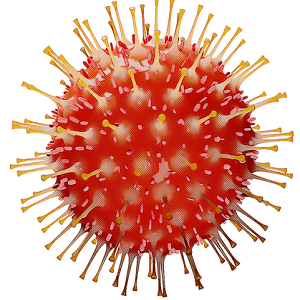
.jpg)
